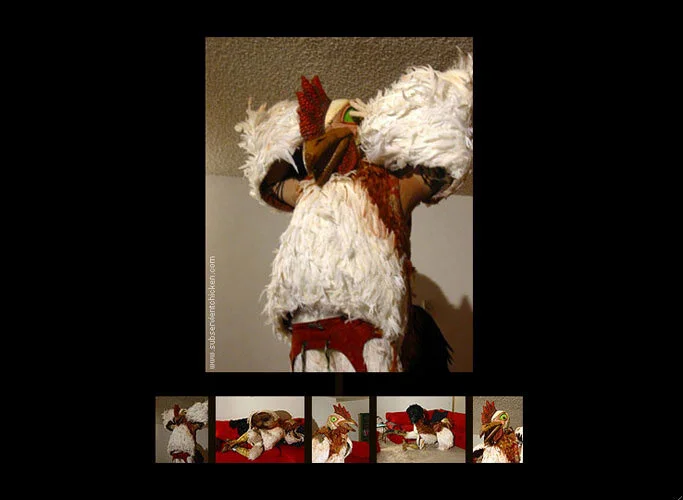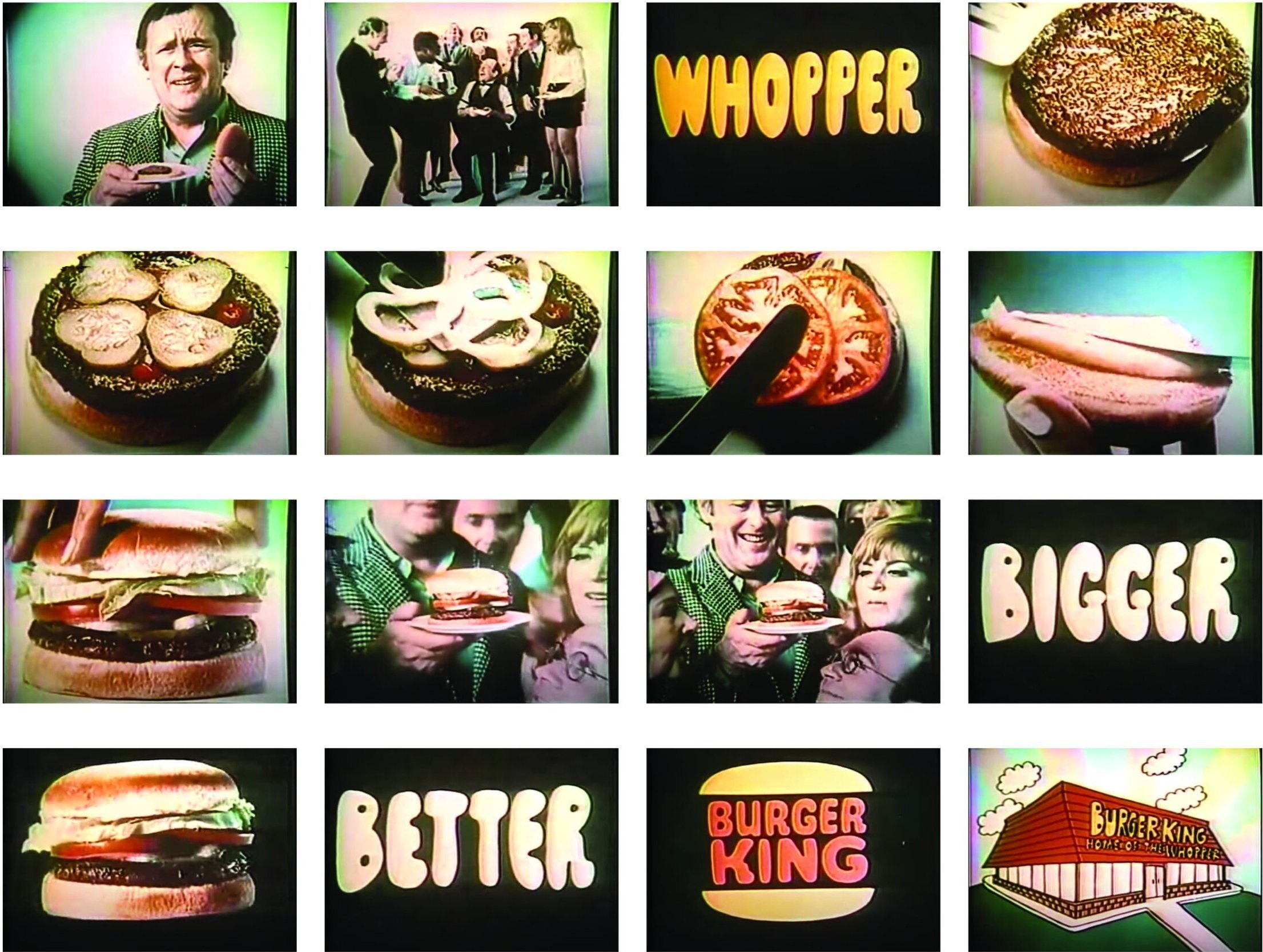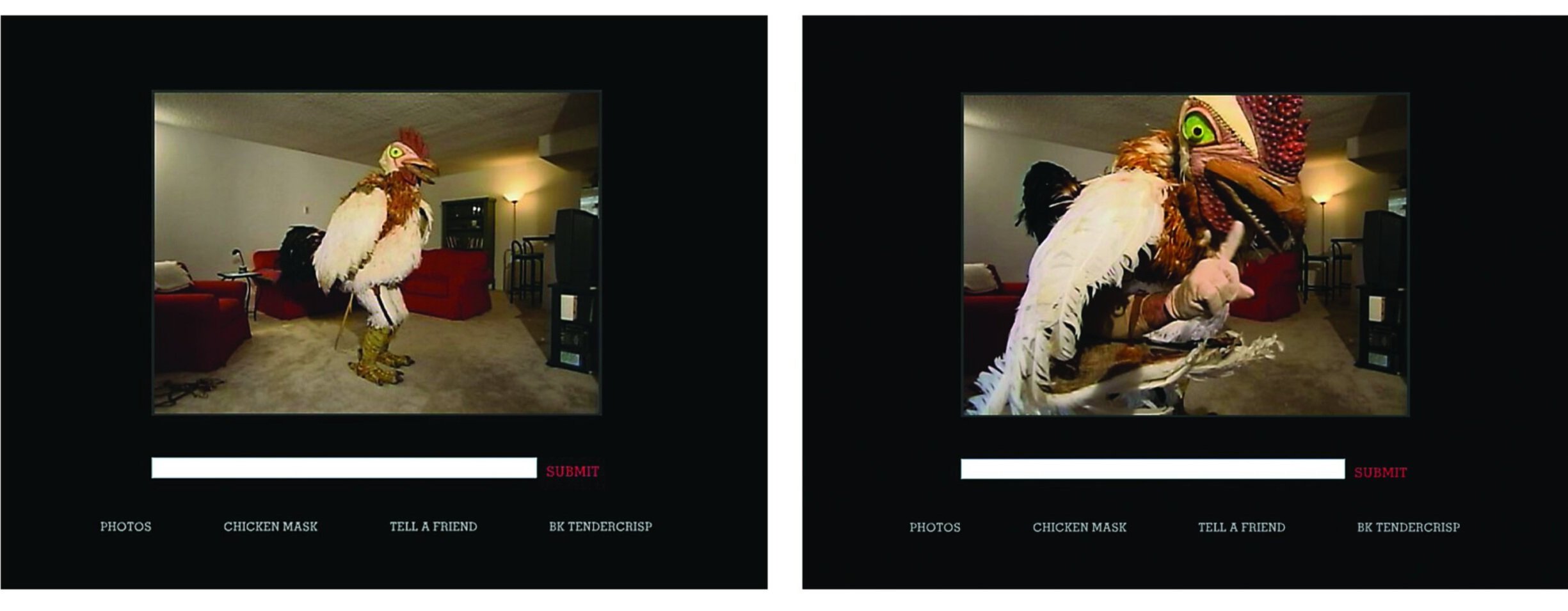Have it Your Way
A Barthesian Analysis of Eroticism in Burger King’s Subservient Chicken
It’s 2004. Twitter doesn’t exist. Facebook’s only for college students. You’re a 26-year-old guy checking your Hotmail account to see what cool new stuff your buddies have sent you today. After forwarding along a couple chain emails, you click on SubservientChicken.com — Chad sent it to you last night, saying you have to check it out. And so now you’re staring at a man in a creepy chicken suit and a garter belt who’s standing in the middle of a dingy living room that looks like it’s from a low budget porno. All you have to do now is type out a command — anything you can think of — and he’ll do it, seemingly live, because he’s “The Subservient Chicken.”
The tactics and semiotics of food advertising have pushed and perverted Roland Barthes’ three general themes of advertising to be significantly more abstract than he originally conceived in “Toward a Psychosociology of Contemporary Food Consumption.” In this piece, Barthes suggests that food advertising generally appeals to consumers by presenting messages that: 1) Are nostalgic of an idealized past, 2) Eroticize food and associate it with subliminal cultural signifiers or 3) Emphasize the traits and qualities of food in service of consumers’ emotional and situational needs. While “The Subservient Chicken” roughly falls within Barthes’ second theme, fast food advertising in the early aughts strived to sell experiences and cultural moments by making the actual food products subliminal to the erotic messaging. A comparison of a Burger King television advertisement from the 1960s that Barthes could have seen to “The Subservient Chicken” campaign from 2004 shows how eroticism in food advertising has morphed and evolved beyond his original conception.
In the 1960s, most fast food advertising was focused on value propositions specifically about the products being offered. A recurring visual trope is the image of a confused and disgruntled person holding a giant bun with a tiny burger patty in the center (This endures through the following decades to later become iconic for Wendy’s in their 1984 “Where’s the Beef?” television spot). In the television spot shown in Figure 2, the offensive tiny burger is then replaced with close-up beauty shots of a woman with manicured hands assembling the Whopper, starting with a thick, glistening patty that’s followed by a swirl of ketchup, four perfect pickle slices, a tangle of sliced onions, two slices of deep red tomatoes and a crisp blanket of lettuce that’s all topped off with a generous smear of mayonnaise on the toasted bun top. The crowd of all-American burger eaters now gaze approvingly at the perfectly assembled Whopper held by our original customer who’s grinning widely at the Whopper in his hand. The last twelve seconds of the ad feature images of the Whopper on a black background while their jingle plays: “The bigger the burger, the better the burger; the burgers are bigger at Burger King! Home of the Whopper.”
Figure 2: Stills from a 1960’s Burger King TV spot highlighting a product message about the size and superior quality of the Whopper compared to unnamed competitors.
The food is the primary focus of this spot, communicating the message that the Whopper is bigger than other restaurants’ burgers and is a full meal, thus better than all other burgers. Through a Barthesian lens, the verbal messaging falls under the third theme — a larger burger is better than a small one because it is a more substantial meal — while the visual messaging falls under the second theme — the burger is positioned as an object of desire through 25 seconds of highly detailed food shots elaborating each ingredient before pulling back to display the Whopper as a whole. In this ad, the Whopper is fulfilling consumers’ need for a bigger burger that can be a full meal. Even though the Whopper is visually transformed into an erotic object worthy of praise, it doesn’t fully transform into a signifier of cultural capital.
By the time Miami-based agency Crispin Porter + Bogusky (CP+B) won the business in 2003, Burger King’s advertising strategy, messaging and visuals hadn’t evolved beyond product and price messages that accompanied beauty shots of the burger being assembled by a disembodied hand (Figure 3). CP+B was a fairly small agency (they’re still around but much bigger nowadays) known for creating subversive 360 campaigns across television spots, print, out-of-home, packaging and digital media. “The Subservient Chicken” is one of the earliest viral web campaigns that won countless industry awards and is still lauded as a touchstone example of innovative technology in advertising.
Figure 3: Stills from a Burger King TV spot circa 2000
The campaign was targeted to white men, aged 16-30, and launched with a 30 second TV spot (Figure 4) that opens with a man telling someone off screen to “Put on that vest” before flipping through multiple Polaroids of a man in a chicken suit. He looks up to see the same chicken in a casual red vest, but the man looks disappointed and says, “Not that one,” before returning to the Polaroids. The chicken emerges from the doorway once more, but this time in a sheer, feminine vest. A raspy male voice over says the campaign tagline: “Chicken: Just the Way You Like it” before the man on screen makes an approving “Mmmm” sound. The spot then cuts to a close up of a hands tearing a piece of fried chicken apart, a series of sandwich shots accompanying some brief product messaging, and finally ends on an in-situ logo lock-up over text reading “SubservientChicken.com.”
Figure 4: Stills from the 30 second 2004 “Subservient Chicken” TV spot that launched SubservientChicken.com.
Keep in mind that, when creating TV spots, creative teams are very intentional about the furniture, lighting, color and wardrobe choices, so the explicit and implicit visual connections to amateur, low budget pornography of the time should be taken as intentional decisions that their target audience would be familiar with (I would venture to say it goes beyond porn and references snuff films).
Once on SubservientChicken.com (Figure 5), visitors could submit commands for the chicken to act out, seemingly in real-time. To create the illusion of real-time responses, CP+B brainstormed more than 400 different commands for an actor in the chicken suit to act out in pre-recorded video clips, including: do the hokey pokey, moonwalk, moulin rouge, spread eagle, pull out feathers, act like a dog, hump the couch, build a fort, and countless others. Any vulgar commands are met with the chicken shaking his finger at the viewers. The site itself is very minimally designed with a solid black background, a video module, a box for text submissions and four text links. The only visual cues associating the site with Burger King are a brief flash of the logo while the page loads, a nondescript text link for “BK TENDERCRISP” under the video module, and a dark grey copyright blurb at the very bottom crediting the site to Burger King. It’s notable to call out that images of the actual TenderCrisp chicken sandwich are nowhere on the site or in the video module.
Figure 5: Visitors to SubservientChicken.com were met with a simple website with a video module, text input box and four text links. There is no persistent and overt Burger King branding or images/messages talking about the TenderCrisp sandwich beyond the far-right text link.
Instead of highlighting the actual food as the hero, “The Subservient Chicken” almost exclusively focuses on a submissive, compliant man dressed in a chicken suit and garter belt getting digitally dominated by consumers. This man in the chicken suit serves as an overtly sexualized symbol and manifestation of the idea that you can get a fried chicken sandwich just the way you like it from Burger King — without actually showing or talking about the sandwich in question.
While activations like this have now become commonplace, at the time the Internet was a new frontier populated by weird digital phenomena disconnected from marketing. The campaign’s online platform reached young men where they were — blogs and message boards — and co-opted the Internet’s visual language, interactivity and mechanics to promote a brand message and sell chicken sandwiches in a way that had never been done before. Rather than communicating that Burger King’s TenderCrisp sandwich is filling and delicious, “The Subservient Chicken” instead positions Burger King as an edgy, contemporary brand that’s in on the joke.
Burger King advertisements from before 2002 closely aligned to Barthes’ second theme of food advertising by devoting the majority of their time to subtly erotic close-up shots of each individual ingredient and multiple views of the final product being sold. However, “The Subservient Chicken” inverts his theme by positioning the TenderCrisp chicken sandwich — the product being sold — as a subliminal association underlying the explicit eroticism of a digitally dominated man in a chicken suit and garter belt. This campaign triggered the beginning of irreverent and nonsensical advertising that ran rampant throughout the first decade of the 2000s (e.g. Old Spice TV ads, KFC merch, Wendy’s Twitter account, and so on) and is indicative of a relatively new theme for food advertising in which brands and consumers create and exchange cultural capital through disruptive or unexpected interactions to attach themselves — on both sides of the equation — to broader cultural moments and signifiers instead of just products.
Seventeen years later, this kind of disruptive-for-disruption’s-sake advertising activation hasn’t aged well for several — maybe obvious — reasons, but the effects of “The Subservient Chicken” still reverberate through advertising today. Many of the campaign’s original creators from Crispin, Porter + Bogusky have gone on to become founders, Chief Creative Officers or Executive Creative Directors for other agencies, where they continue to influence and shape society’s collective psychology through advertising — for better and for worse.





